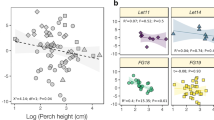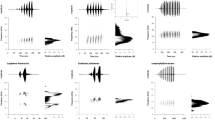Abstract
Although a large proportion of the literature has addressed the direction and preference of female choice in frogs, research about how males locate a breeding site and what strategies are involved in aggregation has been much less explored. By using broadcasting tests on a polyandrous choral treefrog Rhacophorus prasinatus, we examined how male frogs use conspecific and heterospecific signals to locate a chorus by asking the following questions: (1) Do male frogs prefer to join a large or a small chorus? (2) Do male frogs prefer to approach a high-quality or a low-quality male? (3) Do males utilize heterospecific calls to locate the potential breeding sites? (4) Do male frogs orient toward or avoid choruses containing heterospecific calls? Our results indicated that males prefer to join a large rather than small chorus. Low-quality males tend to approach high-quality males, which might be explained as the sneaking behavior of satellite males. Furthermore, males may use heterospecific calls delivered by a noncompetitive sympatric species (a ranid frog) to find potential breeding sites, but not by a sympatric competitor (another rhacophorid frog) that occupies a similar niche. Although the males did not show significant preference between conspecific chorus and mixed-specific chorus in the broadcasting tests, recapture records in the wild indicated that a high ratio of males would leave the mixed-specific choruses and move toward conspecific choruses in the next capture event.
Significance statement
Although a large proportion of the literature has addressed the direction and preference of female choice in frogs, research about how males locate a breeding site and what strategies are involved in aggregation has been much less explored. Our study represents one of the first to test the orientation of males during breeding season, when the spatial scale in the experimental design is comparable to the real situation in the wild. Our results supported the prediction that both conspecific and heterospecific cues are used as information for males to assess the quality of breeding sites. Heterospecific calls may play dual functions for the males, which might become interference when coexisting with conspecific calls but may also provide cues for a potential habitat when conspecific calls are absent.



Similar content being viewed by others
References
Amézquita A, Flechas SV, Lima AP, Gasser H, Hodl W (2011) Acoustic interference and recognition space within a complex assemblage of dendrobatid frogs. Proc Natl Acad Sci USA 108:17058–17063
Beckers OM, Schul J (2004) Phonotaxis in Hyla versicolor (Anura, Hylidae): the effect of absolute call amplitude. J Comp Physiol A 190:869–876
Bee MA (2007) Selective phonotaxis by male wood frogs (Rana sylvatica) to the sound of a chorus. Behav Ecol Sociobiol 61:955–966
Bee MA, Riemersma KK (2008) Does common spatial origin promote the auditory grouping of temporally separated signal elements in grey treefrogs? Anim Behav 76:831–843
Bee MA, Schwartz JJ, Summers K (2013) All’s well that begins wells: celebrating 60 years of animal behaviour and 36 years of research on anuran social behaviour. Anim Behav 85:5–18
Bleach IT, Beckmann C, Both C, Brown GP, Shine R (2015) Noisy neighbours at the frog pond: effects of invasive cane toads on the calling behaviour of native Australian frogs. Behav Ecol Sociobiol 69:675–683
Brepson L, Voituron Y, Lengagne T (2012) Condition-dependent ways to manage acoustic signals under energetic constraint in a tree frog. Behav Ecol 24:488–496
Buxton VL, Ward MP, Sperry JH (2015) Use of chorus sounds for location of breeding habitat in 2 species of anuran amphibians. Behav Ecol 26:1111–1118
Buxton VL, Ward MP, Sperry JH (2018) Evaluation of conspecific attraction as a management tool across several species of anurans. Diversity 10:6
Chen S-L (1992) The reproductive behavior and ecology of emerald green tree frog (Rhacophorus smaragdinus). MSc thesis, National Taiwan Normal University
Chen T-Y (2002) Male advertisement call and female choice in Moltrecht’s treefrog, Rhacophorus moltrechti, from Taiwan. MSc thesis, National Cheng Kung University
Cunnington GM, Fahrig L (2013) Mate attraction by male anurans in the presence of traffic noise. Anim Conserv 16:275–285
Diego-Rasilla FJ, Luengo RM (2004) Heterospecific call recognition and phonotaxis in the orientation behavior of the marbled newt, Triturus marmoratus. Behav Ecol Sociobiol 55:556–560
Farris HE, Ryan MJ (2011) Relative comparisons of call parameters enable auditory grouping in frogs. Nat Commun 2:410
Farris HE, Ryan MJ (2017) Schema vs. primitive perceptual grouping: the relative weighting of sequential vs. spatial cues during an auditory grouping task in frogs. J Comp Physiol A 203:175–182
Fletcher RJ (2009) Does attraction to conspecifics explain the patch-size effect? An experimental test. Oikos 118:1139–1147
Friedl TW, Klump GM (2005) Sexual selection in the lek-breeding European treefrog: body size, chorus attendance, random mating and good genes. Anim Behav 70:1141–1154
Gerhardt HC, Huber F (2002) Acoustic communication in insects and anurans: common problems and diverse solutions. University of Chicago Press, Chicago
Gerhardt HC, Klump GM (1988) Masking of acoustic signals by the chorus background noise in the green tree frog: a limitation on mate choice. Anim Behav 36:1247–1249
Halfwerk W, Lea AM, Guerra MA, Page RA, Ryan MJ (2016) Vocal responses to noise reveal the presence of the Lombard effect in a frog. Behav Ecol 27:669–676
Höbel G (2014) Socially mediated plasticity of chorusing behavior in the gladiator frog Hypsiboas rosenbergi. Acta Ethol 18:145–152
Höbel G, Barta T (2014) Adaptive plasticity in calling site selection in grey treefrogs (Hyla versicolor). Behaviour 151:741–754
Humfeld SC (2013) Condition-dependent signaling and adoption of mating tactics in an amphibian with energetic displays. Behav Ecol 24:859–870
Humfeld SC, Marshall VT, Bee MA (2009) Context-dependent plasticity of aggressive signalling in a dynamic social environment. Anim Behav 78:915–924
James MS, Stockwell MP, Clulow J, Clulow S, Mahony MJ (2015) Investigating behaviour for conservation goals: conspecific call playback can be used to alter amphibian distributions within ponds. Biol Conserv 192:287–293
Kishi S, Nakazawa T (2013) Analysis of species coexistence co-mediated by resource competition and reproductive interference. Popul Ecol 55:305–313
Lu Y-T, Chen S-H (2012) Study on resource partitioning of 6 frogs community in a still waterpond located in the Tatung Shan of New Taipei City. MSc thesis, National Taipei University of Education
Lucas JR, Howard RD, Palmer JG (1996) Callers and satellites: chorus behaviour in anurans as a stochastic dynamic game. Anim Behav 51:501–518
Luther D, Gentry K (2013) Sources of background noise and their influence on vertebrate acoustic communication. Behaviour 150:1045–1068
Madden N, Jehle R (2017) Acoustic orientation in the great crested newt (Triturus cristatus). Amphibia-Reptilia 38:57–65
Magrath RD, Haff TM, Fallow PM, Radford AN (2015) Eavesdropping on heterospecific alarm calls: from mechanisms to consequences. Biol Rev 90:560–586
Miller CW, Fletcher RJ Jr, Gillespie SR (2013) Conspecific and heterospecific cues override resource quality to influence offspring production. PLoS One 8:e70268
Mönkkönen M, Helle P, Niemi GJ, Montgomery K (1997) Heterospecific attraction affects community structure and migrant abundances in northern breeding bird communities. Can J Zool 75:2077–2083
Moreno-Gómez FN, Bacigalupe LD, Silva-Escobar AA, Soto-Gamboa M (2015) Female and male phonotactic responses and the potential effect of sexual selection on the advertisement calls of a frog. Anim Behav 104:79–86
Mou Y, Risch J, Lue K (1983) Rhacophorus prasinatus, a new tree frog from Taiwan, China (Amphibia, Anura, Rhacophoridae). Alytes 2:154–162
Mullet TC, Farina A, Gage SH (2017) The acoustic habitat hypothesis: an ecoacoustics perspective on species habitat selection. Biosemiotics 10:319–336
Murphy CG (2003) The cause of correlations between nightly numbers of male and female barking treefrogs (Hyla gratiosa) attending choruses. Behav Ecol 14:274–281
Neelon DP, Höbel G (2017) Social plasticity in choosiness in green tree frogs, Hyla cinerea. Behav Ecol 28:1540–1546
Peig J, Green AJ (2010) The paradigm of body condition: a critical reappraisal of current methods based on mass and length. Funct Ecol 24:1323–1332
Prestwich KN (1994) The energetics of acoustic signaling in anurans and insects. Am Zool 34:625–643
Rehberg-Besler N, Doucet SM, Mennill DJ (2016) Overlapping vocalizations produce far-reaching choruses: a test of the signal enhancement hypothesis. Behav Ecol 28:494–499
Reichert MS, Gerhardt HC (2011) The role of body size on the outcome, escalation and duration of contests in the grey treefrog, Hyla versicolor. Anim Behav 82:1357–1366
Reichert MS, Symes LB, Höbel G (2016) Lighting up sound preferences: cross-modal influences on the precedence effect in treefrogs. Anim Behav 119:151–159
Rodríguez RL, Araya-Salas M, Gray DA, Reichert MS, Symes LB, Wilkins MR, Safran RJ, Höbel G (2014) How acoustic signals scale with individual body size: common trends across diverse taxa. Behav Ecol 26:168–177
Ryan MJ, Tuttle MD, Taft LK (1981) The costs and benefits of frog chorusing behavior. Behav Ecol Sociobiol 8:273–278
Schwartz JJ, Hunce R, Lentine B, Powers K (2015) Calling site choice and its impact on call degradation and call attractiveness in the gray treefrog, Hyla versicolor. Behav Ecol Sociobiol 70:1–19
Sebastian-Gonzalez E, Sanchez-Zapata JA, Botella F, Ovaskainen O (2010) Testing the heterospecific attraction hypothesis with time-series data on species co-occurrence. Proc R Soc Lond B 277:2983–2990
Stamps JA (1988) Conspecific attraction and aggregation in territorial species. Am Nat 131:329–347
Sullivan BK, Hinshaw SH (1992) Female choice and selection on male calling behavior in the gray treefrog Hyla versicolor. Anim Behav 44:733–744
Swanson EM, Tekmen SM, Bee MA (2007) Do female frogs exploit inadvertent social information to locate breeding aggregations? Can J Zool 85:921–932
Toledo LF, Martins IA, Bruschi DP, Passos MA, Alexandre C, Haddad CFB (2014) The anuran calling repertoire in the light of social context. Acta Ethol 18:87–99
Ursprung E, Hödl W, Ringler M (2009) Phonotactic approach pattern in the neotropical frog Allobates femoralis: a spatial and temporal analysis. Behaviour 146:153–170
Vélez A, Bee MA (2010) Signal recognition by frogs in the presence of temporally fluctuating chorus-shaped noise. Behav Ecol Sociobiol 64:1695–1709
Wells KD (2001) The energetics of calling in frogs. In: Ryan MJ (ed) Anuran communication. Smithsonian Institution Press, Washington, DC, pp 45–60
Wong S, Parada H, Narins PM (2009) Heterospecific acoustic interference: effects on calling in Oophaga pumilio. Biotropica 41:74–80
Zeigler SL, Neel MC, Oliveira L, Raboy BE, Fagan WF (2011) Conspecific and heterospecific attraction in assessments of functional connectivity. Biodivers Conserv 20:2779–2796
Acknowledgments
We appreciate the Department of Forestry and Nature Conservation, Private Chinese Culture University, which provided us the wonderful experimental site for this research. Dr. Yi-Chung Wang and Mr. Jyh-Chin Lin from this department provided us extra helps during the conduction of the experiments. We also appreciate Dr. Yi-Huey Chen, Dr. Pei-Jen Lee Shaner, and Dr. Yu-Ying Hsu for their advice in the experimental design and statistics. Finally, we appreciate the anonymous reviewers for providing precious comments which greatly improved the quality of this paper.
Funding
This work was supported by the Ministry of Science and Technology, Taiwan (MOST 105-2621-B-003-001-MY3).
Author information
Authors and Affiliations
Corresponding author
Ethics declarations
Conflict of interest
The authors declare that they have no conflict of interest.
Ethical approval
All the treatment procedures in this study followed the animal use protocols approved by Institutional Animal Care and Use Committee (IACUC), National Taiwan Normal University (license no. 107023), and Chinese Culture University (CCU-IACUC-104008). All these protocols were further reviewed and certificated by the Forest Bureau, Council of Agriculture, Taiwan (license no. 1041701403-105-002; no. 1061700773-106-026) and were performed in accordance with the local law of the Wildlife Conservation Act in Taiwan.
Additional information
Communicated by K. Summers
Rights and permissions
About this article
Cite this article
Chang, C., Cheng, YC. & Lin, SM. Influence of conspecific and heterospecific cues on phonotaxis behavior in a polyandrous treefrog. Behav Ecol Sociobiol 72, 179 (2018). https://doi.org/10.1007/s00265-018-2593-4
Received:
Revised:
Accepted:
Published:
DOI: https://doi.org/10.1007/s00265-018-2593-4




